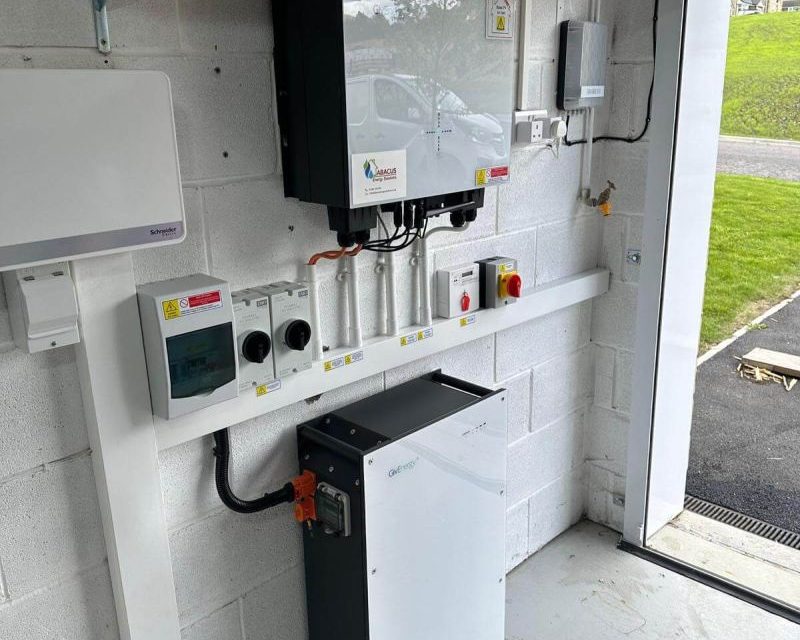The growth of home solar PV panels coupled with battery storage has empowered households to cut electricity bills and carbon emissions.
While awareness around the benefits of solar and storage continues to grow, this could leave another, more accessible, and more affordable route to energy independence in the shadows.
Here, Dave Roberts, UK MD at energy storage specialist GivEnergy makes the case for standalone battery storage without solar.

How does standalone battery storage without solar work?
A standalone domestic battery storage system refers to the use of a home battery that is not paired with any complementary solar. (Unlike a typical solar plus storage setup.) So, rather than using a solar array, it allows households to simply store electricity from the grid when prices are cheaper. This usually includes off-peak periods on smart time of use tariffs, such as overnight.
Households can then use that electricity during more expensive peak hours, such as in the evenings after family members arrive home from school and work. In short, households can maximise the use of cheaper electricity, while minimising reliance on the grid when electricity is more expensive.
Granted, a standalone battery storage system does not bring the same level of energy freedom as systems coupled with renewable technology. That’s because with a standalone storage battery, the charging of the battery system is reliant on the grid.
However, standalone systems offer a viable alternative for those who:
• Cannot afford the high upfront cost of solar PV panels or other renewable technology (such as a wind turbine for home)
• Don’t have the practical means to install renewable technology (lack of roof space for those living in flats, etc.)
The potential of standalone battery storage coupled with smart time of use tariffs
Latest figures regarding smart time of use tariffs suggest uptake among UK households remains low.
According to the Department for Energy Security and Net Zero (DESNZ), 71% of households surveyed were on a standard tariff, as of summer 2022. Meanwhile, just 12% said they were on a time of use tariff, while 17% didn’t know what type of tariff they were on.
A total of 51% expressed willingness to switch to a time of use tariff. However, many of those surveyed appeared to remain unconvinced that switching would bring benefits. Two of the biggest reasons for not wanting to switch included not saving enough money (32%) and not wanting to think about when to use electricity (34%).
In short, shifting the bulk of electricity usage outside of peak hours is either not possible or not worth it for many households.
This is where standalone battery storage could help. By storing cheaper off-peak electricity, households can then discharge their battery to run household appliances as and when required.
In short, standalone battery storage can help households unlock the benefits of smart time of use tariffs without the inconveniences.

Other benefits of standalone battery storage
Reducing bills and tackling fuel poverty
The latest figures for England suggest around 13% of households (3.17 million) were in fuel poverty in 2023. This is projected to decrease slightly in 2024 to around 12.7% (3.12 million).
A report by National Energy Action suggests that around 3 million households will remain in fuel poverty by 2030.
Standalone battery storage is not a silver bullet for alleviating fuel poverty. Not least because the issue is multifaceted, requiring action on heating, insulation, and other areas.
However, when coupled with smart time of use tariffs, a standalone system could be a part of the fuel poverty puzzle.
This is especially true for households without the means, whether financial, practical, or both, to install renewable technology.
Reducing strain on the grid
In Great Britain, the grid is becoming increasingly reliant on carbon free renewable sources of energy, mainly wind and solar.
2022 was a record breaking year with 138TWh of energy generated from carbon free sources.
While renewables are essential in achieving net zero, they also have hour to hour variability. Moreover, with the increase of heat pumps and EVs, annual consumer demand of electricity could rise by 50% by 2035, according to a report co-authored by the Centre for Net Zero.
By allowing consumers to draw less electricity from the grid during peak hours, standalone battery storage can play its part in reducing strain on the grid. This will help ensure that the use of renewables is manageable and the grid won’t need to resort to burning fossil fuels during peak hours.
Challenges in furthering standalone battery storage
On the one hand, the introduction of 0% VAT on installations of standalone battery storage systems could help to reduce barriers.
However, in other areas, action to facilitate battery storage is lacking, not least the Future Homes Standard (FHS).
Due to be implemented in 2025, the FHS sets out standards for new builds. Disappointingly, there is no mention of battery storage, despite an MCS poll suggesting 61% of MPs support such a measure.
Another barrier appears to revolve around messaging. Put simply, many people are still unaware of how a standalone battery storage system works.
According to MCS data, installations of MCS approved battery storage systems hit a record high, with almost 5,000 carried out in 2023. In 2024, that number is already above 2,200, 85% of which have been installed alongside a solar PV system, suggesting that solar and storage is still the go-to choice for many.
It is the responsibility of those working in the energy storage industry to get the message out about the role standalone battery storage can play.
While battery storage coupled with renewables remains the ideal choice, a standalone system can offer a viable alternative in terms of price, and practicality.
In short, it could be something of an unsung hero, reducing entry barriers to energy freedom.



